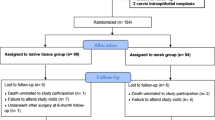Abstract
Our goal was to report the preliminary results of a transvaginal mesh repair of genital prolapse using the Prolift™ system. This retrospective multicentric study includes 110 patients. All patients had a stage 3 (at the hymen) or stage 4 (beyond the hymen) prolapse. Total mesh was used in 59 patients (53.6%), an isolated anterior mesh in 22 patients (20%) and an isolated posterior mesh in 29 patients (26.4%). We report one bladder injury sutured at surgery and two haematomas requiring secondary surgical management. At 3 months, 106 patients were available for follow-up. Mesh exposure occurred in five patients (4.7%), two of them requiring a surgical management. Granuloma without exposure occurred in three patients (2.8%). Failure rate (recurrent prolapse even asymptomatic or low grade symptomatic prolapse) was 4.7%. According to the perioperative and immediate post-operative results, Prolift™ repair seems to be a safe technique to correct pelvic organ prolapse. Anatomical and functional results must be assessed with a long-term follow-up to confirm the effectiveness and safety of the procedure.






Similar content being viewed by others
References
Olsen AL, Smith VJ, Bergstrom JO, Colling JC, Clark AL (1997) Epidemiology of surgically managed pelvic organ prolapse and urinary incontinence. Obstet Gynecol 89:501–506
Clark AL, Gregory T, Smith VJ, Edwards R (2003) Epidemiologic evaluation of reoperation for surgically treated pelvic organ prolapse and urinary incontinence. Am J Obstet Gynecol 189:1261–1267
Whiteside JL, Weber AM, Meyn LA, Walters MD (2004) Risk factors for prolapse recurrence after vaginal repair. Am J Obstet Gynecol 191:1533–1538
Cosson M, Boukerrou M, Lambaudie E, Lobry P, Crépin G, Ego A (2003) [Biomechanics of stress distribution and resistance of biological tissues: why use prostheses for the cure of genital prolapse?] J Gynecol Obstet Biol Reprod (Paris) 32:329–337
Brenner J (1995) Mesh materials in hernia repair. In: Schumpelick V, Wantz GE (eds) Inguinal hernia repair. Expert meeting on hernia surgery, St Moritz, 1994. Karger, Basel, pp 172–179
Gadonneix P, Ercoli A, Scambia G, Villet R (2005) The use of laparoscopic sacrocolpopexy in the management of pelvic organ prolapse. Curr Opin Obstet Gynecol 17:376–380
Benson JT, Lucente V, McClellan E (1996) Vaginal versus abdominal reconstructive surgery for the treatment of pelvic support defects: prospective randomized study with long-term outcome evaluation. Am J Obstet Gynecol 175:1418–1421
Maher CF, Qatawneh AM, Dwyer PL, Carey MP, Cornish A, Schluter PJ (2004) Abdominal sacral colpopexy or vaginal sacrospinous colpopexy for vaginal vault prolapse: a prospective randomized study. Am J Obstet Gynecol 190:20–26
Maher C, Baessler K (2006) Surgical management of anterior vaginal wall prolapse: an evidencebased literature review. Int Urogynecol J Pelvic Floor Dysfunct 17:195–201
Iglesia CB, Fenner DE, Brubaker L (1997) The use of mesh in gynecologic surgery. Int Urogynecol J Pelvic Floor Dysfunct 8:105–115
Julian M (1996) The efficacy of Marlex mesh in the repair of severe, recurrent vaginal prolapse of the anterior migvaginal wall. Am J Obstet Gynecol 175:1472–1475
Ulmsten U, Johnson P, Rezapour M (1999) A three-year follow-up of tension-free vaginal tape for surgical treatment of female stress urinary incontinence. Br J Obstet Gynaecol 10:345–350
Kuuva N, Nilsson CG (2002) A nationwide analysis of complications associated with the tension-free vaginal tape (TVT) procedure. Acta Obstet Gynecol Scand 81:72–77
Cosson M, Boukerrou M, Lobry P, Crépin G, Ego A (2003) [Mechanical properties of biological or synthetic implants used to cure genital prolapse and stress incontinence: what is the ideal material?] J Gynecol Obstet Biol Reprod (Paris) 32:321–328
Debodinance P, Berrocal J, Clavé H, Cosson M, Garbin O, Jacquetin B, Rosenthal C, Salet-Lizée D, Villet R (2004) [Changing attitudes on the surgical treatment of urogenital prolapse: birth of the tension-free vaginal mesh]. J Gynecol Obstet Biol Reprod (Paris) 33:577–588
Richardson DA, Scotti RJ, Ostergard DR (1989) Surgical management of uterine prolapse in young women. J Reprod Med 34:388–392
Fatton B, Jacquetin B (2003) Sacrospinous fixation according to Richter. In Stanton SL, Zimmern PZ (eds) Female pelvic reconstructive surgery, Springer, Berlin Heidelberg New York, pp 192–199
de Leval J (2003) Novel surgical technique for the treatment of female stress urinary incontinence: transobturator vaginal tape inside-out. Eur Urol 44:724–730
Dwyer PL, O’Reilly BA (2004) Transvaginal repair of anterior and posterior compartment prolapse with Atrium polypropylene mesh. BJOG 111:831–836
Nygaard IE, McCreery R, Brubaker L, Connolly A, Cundiff G, Weber AM, Zyczynski H, Pelvic Floor Disorders Network (2004) Abdominal sacrocolpopexy: a comprehensive review. Obstet Gynecol 104:805–823
Cosson M, Caquant F, Collinet P, Rosenthal C, Clave H, Debodinance P, Garbin O, Berrocal J, Villet R, Jacquetin B (2005) Prolift mesh (Gynecare) for pelvic organ prolapse surgical treatment using the TVM group: a retrospective study of 687 patients. Communication in the ICS meeting, Montreal, 31 August 2005
Culligan PJ, Murphy M, Blackwell L, Hammons G, Graham C, Heit MH (2002) Long-term success of abdominal sacral colpopexy using synthetic mesh. Am J Obstet Gynecol 187:1473–1480
Achtari C, Hiscock R, O’Reilly BA, Schierlitz L, Dwyer PL (2005) Risk factors for mesh erosion after transvaginal surgery using polypropylene (Atrium) or composite polypropylene/polyglactin 910 (Vypro II) mesh. Int Urogynecol J Pelvic Floor Dysfunct 16:389–394
Milani R, Salvatore S, Soligo M, Pifarotti P, Meschia M, Cortese M (2005) Functional and anatomical outcome of anterior and posterior vaginal prolapse repair with prolene mesh. BJOG 112:107–111
Dwyer PL, O’Reilly B (2005) Dyspareunia following vaginal surgery for prolapse using polypropylene mesh. Re: paper by Milani et al. BJOG 112:1164
Silva WA, Karram MM (2005) Scientific basis for use of grafts during vaginal reconstructive procedures. Curr Opin Obstet Gynecol 17:519–529
Acknowledgements
The authors would like to thank Dr. Annick Larochelle and Dr. Corinne Dabadie for their contribution with the collection of data.
Author information
Authors and Affiliations
Corresponding author
Rights and permissions
About this article
Cite this article
Fatton, B., Amblard, J., Debodinance, P. et al. Transvaginal repair of genital prolapse: preliminary results of a new tension-free vaginal mesh (Prolift™ technique)—a case series multicentric study. Int Urogynecol J 18, 743–752 (2007). https://doi.org/10.1007/s00192-006-0234-3
Received:
Accepted:
Published:
Issue Date:
DOI: https://doi.org/10.1007/s00192-006-0234-3



